Bioluminescence

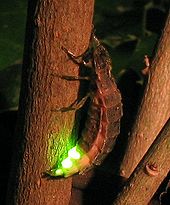

Bioluminescence is the production and emission of light by living organisms. It is a form of chemiluminescence. Bioluminescence occurs widely in marine vertebrates and invertebrates, as well as in some fungi, microorganisms including some bioluminescent bacteria, and terrestrial arthropods such as fireflies. In some animals, the light is bacteriogenic, produced by symbiotic bacteria such as those from the genus Vibrio;[1] in others, it is autogenic, produced by the animals themselves.
In a general sense, the principal chemical reaction in bioluminescence involves a light-emitting molecule and an enzyme, generally called luciferin and luciferase, respectively. Because these are generic names, luciferins and luciferases are often distinguished by the species or group, e.g. firefly luciferin. In all characterized cases, the enzyme catalyzes the oxidation of the luciferin.
In some species, the luciferase requires other
Both Aristotle and Pliny the Elder mentioned that damp wood sometimes gives off a glow. Many centuries later Robert Boyle showed that oxygen was involved in the process, in both wood and glowworms. It was not until the late nineteenth century that bioluminescence was properly investigated. The phenomenon is widely distributed among animal groups, especially in marine environments. On land it occurs in fungi, bacteria and some groups of invertebrates, including insects.
The uses of bioluminescence by animals include
History
Before the development of the
Tuckey, in his posthumous 1818 Narrative of the Expedition to the Zaire, described catching the animals responsible for luminescence. He mentions pellucids, crustaceans (to which he ascribes the milky whiteness of the water), and cancers (shrimps and crabs). Under the microscope he described the "luminous property" to be in the brain, resembling "a most brilliant amethyst about the size of a large pin's head".[8]
Charles Darwin noticed bioluminescence in the sea, describing it in his Journal:
While sailing in these latitudes on one very dark night, the sea presented a wonderful and most beautiful spectacle. There was a fresh breeze, and every part of the surface, which during the day is seen as foam, now glowed with a pale light. The vessel drove before her bows two billows of liquid phosphorus, and in her wake she was followed by a milky train. As far as the eye reached, the crest of every wave was bright, and the sky above the horizon, from the reflected glare of these livid flames, was not so utterly obscure, as over the rest of the heavens.[9]
Darwin also observed a luminous "jelly-fish of the genus Dianaea",[9] noting that: "When the waves scintillate with bright green sparks, I believe it is generally owing to minute crustacea. But there can be no doubt that very many other pelagic animals, when alive, are phosphorescent."[9] He guessed that "a disturbed electrical condition of the atmosphere"[9] was probably responsible. Daniel Pauly comments that Darwin "was lucky with most of his guesses, but not here",[10] noting that biochemistry was too little known, and that the complex evolution of the marine animals involved "would have been too much for comfort".[10]
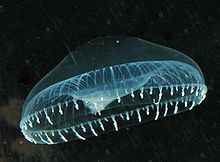
Bioluminescence attracted the attention of the
Among the anecdotes of navigation by bioluminescence is one recounted by the Apollo 13 astronaut Jim Lovell, who as a navy pilot had found his way back to his aircraft carrier USS Shangri-La when his navigation systems failed. Turning off his cabin lights, he saw the glowing wake of the ship, and was able to fly to it and land safely.[13]
The French pharmacologist Raphaël Dubois carried out work on bioluminescence in the late nineteenth century. He studied click beetles (Pyrophorus) and the marine bivalve mollusc Pholas dactylus. He refuted the old idea that bioluminescence came from phosphorus,[14][a] and demonstrated that the process was related to the oxidation of a specific compound, which he named luciferin, by an enzyme.[16] He sent Harvey siphons from the mollusc preserved in sugar. Harvey had become interested in bioluminescence as a result of visiting the South Pacific and Japan and observing phosphorescent organisms there. He studied the phenomenon for many years. His research aimed to demonstrate that luciferin, and the enzymes that act on it to produce light, were interchangeable between species, showing that all bioluminescent organisms had a common ancestor. However, he found this hypothesis to be false, with different organisms having major differences in the composition of their light-producing proteins. He spent the next 30 years purifying and studying the components, but it fell to the young Japanese chemist Osamu Shimomura to be the first to obtain crystalline luciferin. He used the sea firefly Vargula hilgendorfii, but it was another ten years before he discovered the chemical's structure and published his 1957 paper Crystalline Cypridina Luciferin.[17] Shimomura, Martin Chalfie, and Roger Y. Tsien won the 2008 Nobel Prize in Chemistry for their 1961 discovery and development of green fluorescent protein as a tool for biological research.[18]
Harvey wrote a detailed historical account on all forms of luminescence in 1957.[19] An updated book on bioluminescence covering also the twentieth and early twenty-first century was published recently.[20][21]
Evolution
In 1932 E. N. Harvey was among the first to propose how bioluminescence could have evolved.[22] In this early paper, he suggested that proto-bioluminescence could have arisen from respiratory chain proteins that hold fluorescent groups. This hypothesis has since been disproven, but it did lead to considerable interest in the origins of the phenomenon. Today, the two prevailing hypotheses (both concerning marine bioluminescence) are those put forth by Howard Seliger in 1993 and Rees et al. in 1998.[23][24]
Seliger's theory identifies luciferase enzymes as the catalyst for the evolution of bioluminescent systems. It suggests that the original purpose of luciferases was as mixed-function oxygenases. As the early ancestors of many species moved into deeper and darker waters natural selection favored the development of increased eye sensitivity and enhanced visual signals.[25] If selection were to favor a mutation in the oxygenase enzyme required for the breakdown of pigment molecules (molecules often associated with spots used to attract a mate or distract a predator) it could have eventually resulted in external luminescence in tissues.[23]
Rees et al. use evidence gathered from the marine luciferin coelenterazine to suggest that selection acting on luciferins may have arisen from pressures to protect oceanic organisms from potentially deleterious reactive oxygen species (e.g. H2O2 and O2− ). The functional shift from antioxidation to bioluminescence probably occurred when the strength of selection for antioxidation defense decreased as early species moved further down the water column. At greater depths exposure to ROS is significantly lower, as is the endogenous production of ROS through metabolism.[24]
While popular at first, Seliger's theory has been challenged, particularly on the biochemical and genetic evidence that Rees examines. What remains clear, however, is that bioluminescence has evolved independently at least 40 times.[26] Bioluminescence in fish began at least by the Cretaceous period. About 1,500 fish species are known to be bioluminescent; the capability evolved independently at least 27 times. Of these, 17 involved the taking up of bioluminous bacteria from the surrounding water while in the others, the intrinsic light evolved through chemical synthesis. These fish have become surprisingly diverse in the deep ocean and control their light with the help of their nervous system, using it not just to lure prey or hide from predators, but also for communication.[27][28]
All bioluminescent organisms have in common that the reaction of a "luciferin" and oxygen is catalyzed by a luciferase to produce light.[29] McElroy and Seliger proposed in 1962 that the bioluminescent reaction evolved to detoxify oxygen, in parallel with photosynthesis.[30]
Thuesen, Davis et al. showed in 2016 that bioluminescence has evolved independently 27 times within 14 fish clades across ray-finned fishes.[27] The oldest of these appears to be Stomiiformes and Myctophidae.[31] In sharks, bioluminescence has evolved only once.[32]
Chemical mechanism

Bioluminescence is a form of chemiluminescence where light energy is released by a chemical reaction. This reaction involves a light-emitting pigment, the luciferin, and a luciferase, the enzyme component.[33] Because of the diversity of luciferin/luciferase combinations, there are very few commonalities in the chemical mechanism. From currently studied systems, the only unifying mechanism is the role of molecular oxygen; often there is a concurrent release of carbon dioxide (CO2). For example, the firefly luciferin/luciferase reaction requires magnesium and ATP and produces CO2, adenosine monophosphate (AMP) and pyrophosphate (PP) as waste products. Other cofactors may be required, such as calcium (Ca2+) for the photoprotein aequorin, or magnesium (Mg2+) ions and ATP for the firefly luciferase.[34] Generically, this reaction can be described as:
- Luciferin + O2Oxyluciferin + light energy

Instead of a luciferase, the jellyfish Aequorea victoria makes use of another type of protein called a photoprotein, in this case specifically aequorin.[35] When calcium ions are added, rapid catalysis creates a brief flash quite unlike the prolonged glow produced by luciferase. In a second, much slower step, luciferin is regenerated from the oxidized (oxyluciferin) form, allowing it to recombine with aequorin, in preparation for a subsequent flash. Photoproteins are thus enzymes, but with unusual reaction kinetics.[36] Furthermore, some of the blue light released by aequorin in contact with calcium ions is absorbed by a green fluorescent protein, which in turn releases green light in a process called resonant energy transfer.[37]
Overall, bioluminescence has arisen over 40 times in evolutionary history.
Distribution
Bioluminescence occurs widely among animals, especially in the open sea, including
The most frequently encountered bioluminescent organisms may be the dinoflagellates in the surface layers of the sea, which are responsible for the sparkling luminescence sometimes seen at night in disturbed water. At least 18 genera exhibit luminosity.[33] Luminescent dinoflagellate ecosystems are present in warm water lagoons and bays with narrow openings to the ocean.[41] A different effect is the thousands of square miles of the ocean which shine with the light produced by bioluminescent bacteria, known as mareel or the milky seas effect.[42]
Pelagic zone
Bioluminescence is abundant in the pelagic zone, with the most concentration at depths devoid of light and surface waters at night. These organisms participate in diurnal vertical migration from the dark depths to the surface at night, dispersing the population of bioluminescent organisms across the pelagic water column. The dispersal of bioluminescence across different depths in the pelagic zone has been attributed to the selection pressures imposed by predation and the lack of places to hide in the open sea. In depths where sunlight never penetrates, often below 200m, the significance of bioluminescent is evident in the retainment of functional eyes for organisms to detect bioluminescence.[43]
Bacterial symbioses
Organisms often produce bioluminescence themselves, rarely do they generate it from outside phenomena. However, there are occasions where bioluminescence is produced by bacterial symbionts that have a symbiotic relationship with the host organism. Although many luminous bacteria in the marine environment are free-living, a majority are found in symbiotic relationships that involve fish, squids, crustaceans etc. as hosts. Most luminous bacterial inhabit the marine sea, with Photobacterium and Vibrio genera dominating the marine environment.[44]
In the symbiotic relationship, bacterium benefit from having a source of nourishment and a refuge to grow. Hosts obtain these bacterial symbionts either from the environment, spawning, or the luminous bacterium is evolving with their host.[45] Coevolutionary interactions are suggested as host organisms’ anatomical adaptations have become specific to only certain luminous bacteria, to suffice ecological dependence of bioluminescence.[46]
Benthic zone
Bioluminescence is widely studied amongst species located in the mesopelagic zone, but the benthic zone at mesopelagic depths has remained widely unknown. Benthic habitats at depths beyond the mesopelagic are also poorly understood due to the same constraints. Unlike the pelagic zone where the emission of light is undisturbed in the open sea, the occurrence of bioluminescence in the benthic zone is less common. It has been attributed to the blockage of emitted light by a number of sources such as the sea floor, and inorganic and organic structures. Visual signals and communication that is prevalent in the pelagic zone such as counter-illumination may not be functional or relevant in the benthic realm. Bioluminescence in bathyal benthic species still remains poorly studied due to difficulties of the collection of species at these depths.[47]
Uses in nature
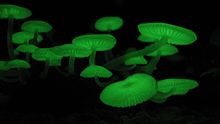
Bioluminescence has several functions in different taxa. Steven Haddock et al. (2010) list as more or less definite functions in marine organisms the following: defensive functions of startle, counterillumination (camouflage), misdirection (smoke screen), distractive body parts, burglar alarm (making predators easier for higher predators to see), and warning to deter settlers; offensive functions of lure, stun or confuse prey, illuminate prey, and mate attraction/recognition. It is much easier for researchers to detect that a species is able to produce light than to analyze the chemical mechanisms or to prove what function the light serves.[33] In some cases the function is unknown, as with species in three families of earthworm (Oligochaeta), such as Diplocardia longa, where the coelomic fluid produces light when the animal moves.[48] The following functions are reasonably well established in the named organisms.
Counterillumination camouflage
In many animals of the deep sea, including several
Attraction
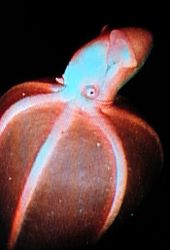
Bioluminescence is used in a variety of ways and for different purposes. The cirrate octopod Stauroteuthis syrtensis uses emits bioluminescence from its sucker like structures.[51] These structures are believed to have evolved from what are more commonly known as octopus suckers. They do not have the same function as the normal suckers because they no longer have any handling or grappling ability due its evolution of photophores. The placement of the photophores are within the animals oral reach, which leads researchers to suggest that it uses it bioluminescence to capture and lure prey.[52]
Fireflies use light to attract mates. Two systems are involved according to species; in one, females emit light from their abdomens to attract males; in the other, flying males emit signals to which the sometimes sedentary females respond.[48][53] Click beetles emit an orange light from the abdomen when flying and a green light from the thorax when they are disturbed or moving about on the ground. The former is probably a sexual attractant but the latter may be defensive.[48] Larvae of the click beetle Pyrophorus nyctophanus live in the surface layers of termite mounds in Brazil. They light up the mounds by emitting a bright greenish glow which attracts the flying insects on which they feed.[48]
In the marine environment, use of luminescence for mate attraction is chiefly known among ostracods, small shrimp-like crustaceans, especially in the family Cyprididae. Pheromones may be used for long-distance communication, with bioluminescence used at close range to enable mates to "home in".[33] A polychaete worm, the Bermuda fireworm creates a brief display, a few nights after the full moon, when the female lights up to attract males.[54]
Defense
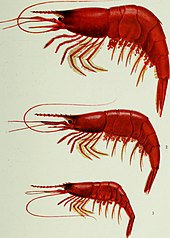
The defense mechanisms for bioluminescent organisms can come in multiple forms; startling prey, counter-illumination, smoke screen or misdirection, distractive body parts, burglar alarm, sacrificial tag or warning coloration. The shrimp family Oplophoridae Dana use their bioluminescence as a way of startling the predator that is after them.[55] Acanthephyra purpurea, within the Oplophoridae family, uses its photophores to emit light, and can secrete a bioluminescent substance when in the presence of a predator. This secretory mechanism is common among prey fish.[55]
Many
The sea-firefly is a small crustacean living in sediment. At rest it emits a dull glow but when disturbed it darts away leaving a cloud of shimmering blue light to confuse the predator. During World War II it was gathered and dried for use by the Japanese army as a source of light during clandestine operations.[17]
The larvae of railroad worms (Phrixothrix) have paired photic organs on each body segment, able to glow with green light; these are thought to have a defensive purpose.[56] They also have organs on the head which produce red light; they are the only terrestrial organisms to emit light of this color.[57]
Warning
Aposematism is a widely used function of bioluminescence, providing a warning that the creature concerned is unpalatable. It is suggested that many firefly larvae glow to repel predators; some millipedes glow for the same purpose.[58] Some marine organisms are believed to emit light for a similar reason. These include scale worms, jellyfish and brittle stars but further research is needed to fully establish the function of the luminescence. Such a mechanism would be of particular advantage to soft-bodied cnidarians if they were able to deter predation in this way.[33] The limpet Latia neritoides is the only known freshwater gastropod that emits light. It produces greenish luminescent mucus which may have an anti-predator function.[59] The marine snail Hinea brasiliana uses flashes of light, probably to deter predators. The blue-green light is emitted through the translucent shell, which functions as an efficient diffuser of light.[60]
Communication
Communication in the form of quorum sensing plays a role in the regulation of luminescence in many species of bacteria. Small extracellularly secreted molecules stimulate the bacteria to turn on genes for light production when cell density, measured by concentration of the secreted molecules, is high.[33]
Some bioluminous bacteria infect nematodes that parasitize Lepidoptera larvae. When these caterpillars die, their luminosity may attract predators to the dead insect thus assisting in the dispersal of both bacteria and nematodes.[48] A similar reason may account for the many species of fungi that emit light. Species in the genera Armillaria, Mycena, Omphalotus, Panellus, Pleurotus and others do this, emitting usually greenish light from the mycelium, cap and gills. This may attract night-flying insects and aid in spore dispersal, but other functions may also be involved.[48]
Quantula striata is the only known bioluminescent terrestrial mollusk. Pulses of light are emitted from a gland near the front of the foot and may have a communicative function, although the adaptive significance is not fully understood.[63]
Mimicry
Bioluminescence is used by a variety of animals to
The cookiecutter shark uses bioluminescence to camouflage its underside by counter-illumination, but a small patch near its pectoral fins remains dark, appearing as a small fish to large predatory fish like tuna and mackerel swimming beneath it. When such fish approach the lure, they are bitten by the shark.[65][66]
Female Photuris fireflies sometimes mimic the light pattern of another firefly, Photinus, to attract its males as prey. In this way they obtain both food and the defensive chemicals named lucibufagins, which Photuris cannot synthesize.[67]
South American giant cockroaches of the genus Lucihormetica were believed to be the first known example of defensive mimicry, emitting light in imitation of bioluminescent, poisonous click beetles.[68] However, doubt has been cast on this assertion, and there is no conclusive evidence that the cockroaches are bioluminescent.[69][70]

Illumination
While most marine bioluminescence is green to blue, some deep sea
The angler siphonophore (Erenna) utilizes red bioluminescence in appendages to lure fish.[73]
Biotechnology
Biology and medicine
Bioluminescent organisms are a target for many areas of research. Luciferase systems are widely used in genetic engineering as reporter genes, each producing a different color by fluorescence,[75][76] and for biomedical research using bioluminescence imaging.[77][78][79] For example, the firefly luciferase gene was used as early as 1986 for research using transgenic tobacco plants.[80] Vibrio bacteria symbiose with marine invertebrates such as the Hawaiian bobtail squid (Euprymna scolopes), are key experimental models for bioluminescence.[81][82] Bioluminescent activated destruction is an experimental cancer treatment.[83]
In Vivo luminescence cell and animal imaging uses dyes and fluorescent proteins as chromophores. The characteristics of each chromophore determine which cell area(s) will be targeted and illuminated.[84]
Light production
The structures of
ATP bioluminescence
ATP bioluminescence is the process in which ATP is used to generate luminescence in an organism, in conjunction with other compounds such as luciferin. It proves to be a very good
See also
- Animal coloration
- Biophoton
- Life That Glows, 2016 full-length documentary
Notes
References
- ^ Ples, Marek (11 November 2021). "Lab Snapshots by Marek Ples; Microbiology - The biology on a different level". weirdscience.eu. Retrieved 2 July 2023.
- ^ Callaway, E. 2013. Glowing plants spark debate. Nature, 498:15–16, 4 June 2013. http://www.nature.com/news/glowing-plants-spark-debate-1.13131
- ISBN 978-0-7153-4281-7. (ISBN refers to the David & Charles reprint of 1968 with an introduction by L. T. C. Rolt)
- ISBN 978-0-09-947884-3.
- ISBN 9780902833999.
- ^ Harvey cites this as Baker, J.: 1743–1753, The Microscope Made Easy and Employment for the Microscope.
- ^ Harvey, E. Newton (1920). The Nature of Animal Light. Philadelphia & London: J. B. Lippencott. p. 1.
- ^ Tuckey, James Hingston (May 1818). Thomson, Thomas (ed.). "Narrative of the Expedition to the Zaire". Annals of Philosophy. 11 (65): 392.
- ^ a b c d Darwin, Charles (1839). Narrative of the surveying voyages of His Majesty's Ships Adventure and Beagle between the years 1826 and 1836, describing their examination of the southern shores of South America, and the Beagle's circumnavigation of the globe. Journal and remarks. 1832–1836. Henry Colburn. pp. 190–192.
- ^ ISBN 978-1-139-45181-9.
- PMID 7654844.
- ^ a b "How illuminating". The Economist. 10 March 2011. Retrieved 6 December 2014.
- ISBN 978-0-674-07282-4.
- ^ Reshetiloff, Kathy (1 July 2001). "Chesapeake Bay night-lights add sparkle to woods, water". Bay Journal. Archived from the original on 1 May 2019. Retrieved 16 December 2014.
- ^ "Luminescence". Encyclopædia Britannica. Retrieved 16 December 2014.
- PMID 20533808.
- ^ ISBN 978-0-674-01921-8.
- ^ "The Nobel Prize in Chemistry 2008". 8 October 2008. Retrieved 23 November 2014.
- ^ Harvey, E. Newton (1957). A History of Luminescence: From the Earliest Times Until 1900. Philadelphia: American Philosophical Society.
- ISBN 978-0-7735-5312-5.
- ^ Fulcher, Bob. "Lovely and Dangerous Lights" (PDF). Tennessee Conservationist Magazine. Archived from the original (PDF) on 14 August 2014. Retrieved 28 November 2014.
- ^ Harvey, E.N. (1932). "The evolution of bioluminescence and its relation to cell respiration". Proceedings of the American Philosophical Society. 71: 135–141.
- ^ a b Seliger, H.H. (1993). "Bioluminescence: excited states under cover of darkness". Naval Research Reviews. 45.
- ^ PMID 9510532.
- ^ Widder, Edith A. (1999). Archer, S.; Djamgoz, M.B.; Loew, E.; Partridge, J.C.; Vallerga, S. (eds.). Bioluminescence. Adaptive Mechanisms in the Ecology of Vision. Springer. pp. 555–581.
- S2CID 3872860.
- ^ PMID 27276229.
- ^ Yong, Ed (8 June 2016). "Surprising History of Glowing Fish". Phenomena. National Geographic. Archived from the original on 9 June 2016. Retrieved 11 June 2016.
- PMID 9891783.
- ISSN 0036-8733.
- ^ "Neuronal Regulation of Bioluminescence". www.sciencedirect.com.
- ^ Illuminating the evolution of bioluminescence in sharks
- ^ S2CID 3872860.
- S2CID 875590.
- PMID 13911999.
- S2CID 4176627.
- PMID 4151620.
- PMID 28374789.
- PMID 34580316.
- PMID 24421880.
- ^ "Bioluminescence | National Geographic Society". education.nationalgeographic.org. Retrieved 28 January 2023.
- ^ Ross, Alison (27 September 2005). "'Milky seas' detected from space". BBC. Retrieved 13 March 2013.
- S2CID 85259393.
- ISBN 978-981-238-156-9.
- PMID 31571583.
- S2CID 31107773.
- PMID 22956246.
- ^ a b c d e f Viviani, Vadim (17 February 2009). "Terrestrial bioluminescence". Retrieved 26 November 2014.
- ^ S2CID 11284796.
- PMID 19509343.
- PMID 28296499.
- PMID 21141672.
- PMID 17644427.
- ISBN 978-981-4366-08-3.
- ^ PMID 25482362.
- ^ Branham, Marc. "Glow-worms, railroad-worms (Insecta: Coleoptera: Phengodidae)". Featured Creatures. University of Florida. Retrieved 29 November 2014.
- .
- PMID 21959150.
- .
- PMID 21159673.
- S2CID 42380533.
- ISBN 978-0-7614-7418-0.
- ^ Copeland, J.; Daston, M. M. (1989). "Bioluminescence in the terrestrial snail Quantula (Dyakia) striata". Malacologia. 30 (1–2): 317–324.
- ^ Young, Richard Edward (October 1983). "Oceanic Bioluminescence: an Overview of General Functions". Bulletin of Marine Science. 33 (4): 829–845.
- ^ Martin, R. Aidan. "Biology of Sharks and Rays: Cookiecutter Shark". ReefQuest Centre for Shark Research. Retrieved 13 March 2013.
- ^ Milius, S. (1 August 1998). "Glow-in-the-dark shark has killer smudge". Science News. Archived from the original on 7 December 2009. Retrieved 13 March 2013.
- PMID 9275191.
- ^ Sullivan, Rachel (16 July 2014). "Out of the darkness". ABC Science. Retrieved 17 December 2014.
- ^ Greven, Hartmut; Zwanzig, Nadine (2013). "Courtship, Mating, and Organisation of the Pronotum in the Glowspot Cockroach Lucihormetica verrucosa (Brunner von Wattenwyl, 1865) (Blattodea: Blaberidae)". Entomologie Heute. 25: 77–97.
- S2CID 33240197.
- ^ S2CID 86463272.
- S2CID 31510972.
- ^ S2CID 29284690.
- ^ OCLC 244632464.
- PMID 17597079.
- PMID 24382456.
- PMID 15616318.
- S2CID 21603693.[permanent dead link]
- PMID 18263704.
- S2CID 32603977.
- PMID 23819708.
- ^ "Comprehensive Squid-Vibrio Publications List". University of Wisconsin-Madison. Archived from the original on 19 October 2014.
- ^ Ludwig Institute for Cancer Research (21 April 2003). "Firefly Light Helps Destroy Cancer Cells; Researchers Find That The Bioluminescence Effects of Fireflies May Kill Cancer Cells From Within". Science Daily. Retrieved 4 December 2014.
- S2CID 233628296.
- ^ Bioluminescence Questions and Answers. Siobiolum.ucsd.edu. Retrieved on 20 October 2011.
- ^ (4 May 2013) One Per Cent: Grow your own living lights The New Scientist, Issue 2915, Retrieved 7 May 2013
- ^ Dr. Chris Riley, "Glowing plants reveal touch sensitivity", BBC 17 May 2000.
- ^ Halverson, Nic (15 August 2013). "Bacteria-Powered Light Bulb Is Electricity-Free".
- ^ Swaminathan, Miep. "Philips launches 'Microbial Home' new forward looking design concepts". Retrieved 8 May 2017.[permanent dead link]
- ^ Cha, Bonnie (28 November 2011). "Philips Bio-light creates mood lighting with bacteria".
- ^ "E.glowli Cambridge: Parts submitted". iGEM. Retrieved 6 December 2014.
- ^ a b Marcellin, Frances (26 February 2016). "Glow-in-the-dark bacterial lights could illuminate shop windows 2016". New Scientist.
- ^ "Glowee: A vision of night-time lighting". Electricite de France. 2015. Retrieved 4 March 2016.
- ^ a b "Glow-in-the-dark bacterial lights could illuminate shop windows". New Scientist. 26 February 2016.
- S2CID 216559981.
- PMID 28666419.
- ISSN 1687-725X.
- PMID 19373229.
Further reading
- Victor Benno Meyer-Rochow (2009) Bioluminescence in Focus – a collection of illuminating essays Research Signpost: ISBN 978-81-308-0357-9
- ISBN 981-256-801-8.
- Lee, John (2016). "Bioluminescence, the Nature of the Light." The University of Georgia Libraries. http://hdl.handle.net/10724/20031
- Wilson, T.; Hastings, J.W. (1998). "Bioluminescence". Annual Review of Cell and Developmental Biology. 14: 197–230. PMID 9891783.
- Anctil, Michel (2018). Luminous Creatures: The History and Science of Light Production in Living Organisms. McGill-Queen's University Press. ISBN 978-0-7735-5312-5
External links
- BBC: Red tide: Electric blue waves wash California shore
- MBARI: Gonyaulax Bioluminescence
- UF/IFAS: glow-worms
- TED: Glowing life in an underwater world (video)
- Smithsonian Ocean Portal: Bioluminescent animals photo gallery
- National Geographic: Bioluminescence
- Annual Review of Marine Science: Bioluminescence in the Sea
- Canon Australia – Tips on How to Photograph Bioluminescence
- The Ottawa, Canada-based Canadian Museum of Nature and Chicago's Field Museum of Natural History) webpage: [1]

![{\displaystyle {\ce {->[{\text{Luciferase}}][{\text{other cofactors}}]}}}](https://wikimedia.org/api/rest_v1/media/math/render/svg/7fc548f6e38ad4d0d3e96ade1fcfb5a2008d5376)

